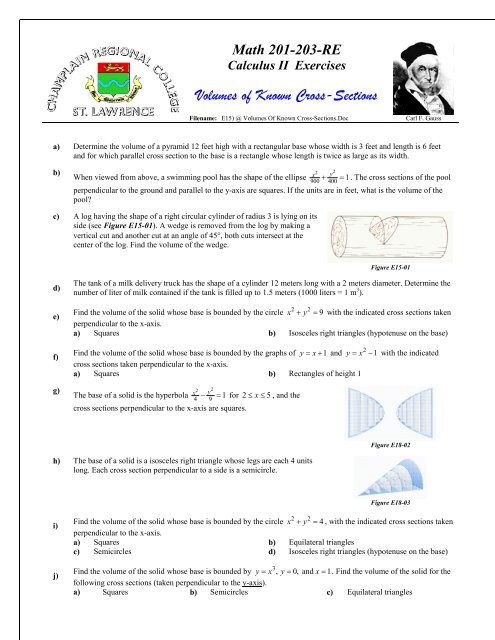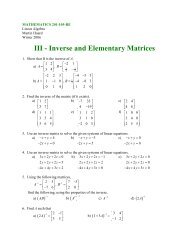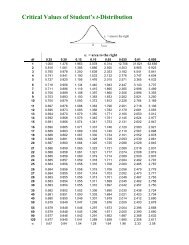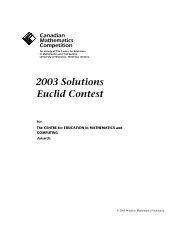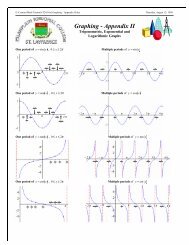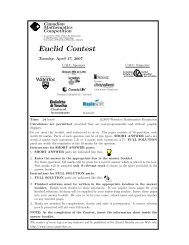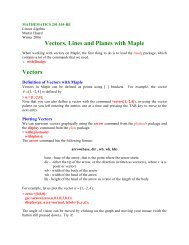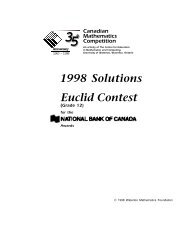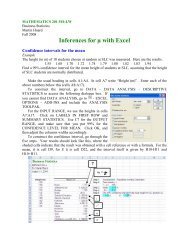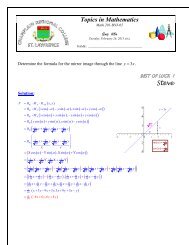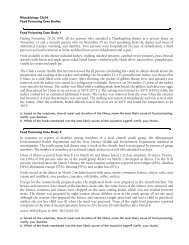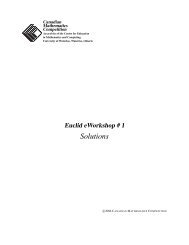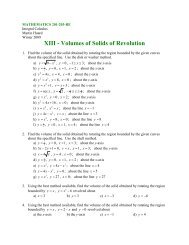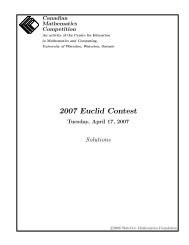Volumes of Known Cross-Sections - SLC Home Page
Volumes of Known Cross-Sections - SLC Home Page
Volumes of Known Cross-Sections - SLC Home Page
Create successful ePaper yourself
Turn your PDF publications into a flip-book with our unique Google optimized e-Paper software.
Math 201-203-RE<br />
Calculus II Exercises<br />
<strong>Volumes</strong> <strong>of</strong> <strong>Known</strong> <strong>Cross</strong>-<strong>Sections</strong><br />
Filename: E15) @ <strong>Volumes</strong> Of <strong>Known</strong> <strong>Cross</strong>-<strong>Sections</strong>.Doc<br />
Carl F. Gauss<br />
a) Determine the volume <strong>of</strong> a pyramid 12 feet high with a rectangular base whose width is 3 feet and length is 6 feet<br />
and for which parallel cross section to the base is a rectangle whose length is twice as large as its width.<br />
b)<br />
When viewed from above, a swimming pool has the shape <strong>of</strong> the ellipse<br />
2 2<br />
y<br />
900 400<br />
x<br />
+ = 1 . The cross sections <strong>of</strong> the pool<br />
perpendicular to the ground and parallel to the y-axis are squares. If the units are in feet, what is the volume <strong>of</strong> the<br />
pool?<br />
c) A log having the shape <strong>of</strong> a right circular cylinder <strong>of</strong> radius 3 is lying on its<br />
side (see Figure E15-01). A wedge is removed from the log by making a<br />
vertical cut and another cut at an angle <strong>of</strong> 45°, both cuts intersect at the<br />
center <strong>of</strong> the log. Find the volume <strong>of</strong> the wedge.<br />
Figure E15-01<br />
d)<br />
e)<br />
f)<br />
g)<br />
The tank <strong>of</strong> a milk delivery truck has the shape <strong>of</strong> a cylinder 12 meters long with a 2 meters diameter. Determine the<br />
number <strong>of</strong> liter <strong>of</strong> milk contained if the tank is filled up to 1.5 meters (1000 liters = 1 m 3 ).<br />
2 2<br />
Find the volume <strong>of</strong> the solid whose base is bounded by the circle x + y = 9 with the indicated cross sections taken<br />
perpendicular to the x-axis.<br />
a) Squares b) Isosceles right triangles (hypotenuse on the base)<br />
Find the volume <strong>of</strong> the solid whose base is bounded by the graphs <strong>of</strong> y = x + 1 and y = x − 1 with the indicated<br />
cross sections taken perpendicular to the x-axis.<br />
a) Squares b) Rectangles <strong>of</strong> height 1<br />
The base <strong>of</strong> a solid is the hyperbola<br />
2 2<br />
y<br />
4 9<br />
x − = 1 for 2 ≤ x ≤ 5 , and the<br />
cross sections perpendicular to the x-axis are squares.<br />
2<br />
Figure E18-02<br />
h) The base <strong>of</strong> a solid is a isosceles right triangle whose legs are each 4 units<br />
long. Each cross section perpendicular to a side is a semicircle.<br />
Figure E18-03<br />
i)<br />
j)<br />
2 2<br />
Find the volume <strong>of</strong> the solid whose base is bounded by the circle x + y = 4 , with the indicated cross sections taken<br />
perpendicular to the x-axis.<br />
a) Squares b) Equilateral triangles<br />
c) Semicircles d) Isosceles right triangles (hypotenuse on the base)<br />
Find the volume <strong>of</strong> the solid whose base is bounded by y = x 3 , y = 0, and x = 1. Find the volume <strong>of</strong> the solid for the<br />
following cross sections (taken perpendicular to the y-axis).<br />
a) Squares b) Semicircles c) Equilateral triangles
a)<br />
ANSWERS:<br />
3<br />
72 ft b)<br />
3<br />
64000 ft<br />
c)<br />
3<br />
18 u d) ≈ 30329 liters<br />
e) a)<br />
3<br />
144 u b)<br />
3<br />
36 u<br />
f) a)<br />
81 3<br />
10 u b) 9 3<br />
2 u<br />
g) 3<br />
243 u h)<br />
8π<br />
3<br />
3 u<br />
i) a)<br />
128<br />
3<br />
3<br />
u b)<br />
32 3<br />
3<br />
3<br />
u c)<br />
16<br />
3<br />
3<br />
π<br />
u<br />
d)<br />
32 3<br />
3 u<br />
j) a)<br />
1 3<br />
10 u b) 3<br />
80 u<br />
π<br />
c)<br />
3 3<br />
40 u


